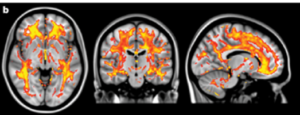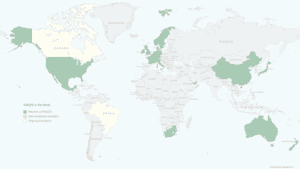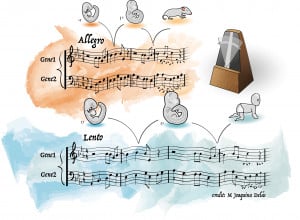
Oxford scientists report in Nature this week on exciting new insights into the structure and function of the brain using genetic information and detailed brain images from UK Biobank.
The researchers took data from detailed MR images from 10,000 UK Biobank participants, which are freely available from the resource to researchers around the world, to examine thousands of different measurements of the brain. It is hoped their results will provide a huge impetus to new research for a wide range of degenerative and psychiatric disorders. With a further 20,000 participants already imaged, and 70,000 more to be scanned in the next three years, the resource is set to transform research into brain development and aging, and understanding how it functions, becomes damaged by disease and heals itself, the scientists say.
The research has been led by Professor Stephen Smith, from Oxford’s Wellcome Trust Centre for Integrative Neuroimaging and Professor Jonathan Marchini, at the Wellcome Centre for Human Genetics, Oxford [2] .
“We have had a tantalising glimpse of what could be,” said Professor Smith. “These game-changing data stored within the UK Biobank resource, and growing in size and value all the time, will revolutionize our understanding of complex brain disorders. “Both the genetics and imaging data are unparalleled in their depth and breadth. With imaging experts working alongside geneticists we hope to discover the causes of a wide range of brain disorders and find new ways to treat them.” He said researchers were excited about what they had discovered. “We have found a genetic fingerprint on some of the most fundamental processes that allow us to think, act and function, from the size of the parts of the central nervous system that control sight, hearing, speech, emotions and actions to the integrity of the communications channels between them and the strength of the signals within them,” he said. The findings might help to better understand and ultimately improve treatments for a wide range of brain disorders, he said.
In particular, the researchers studied 3,144 different measures of brain structure and function, resulting in the discovery of more than 100 areas of the human genome that influence the brain
- Results revealed the effects of genes coding for a “scaffold for tissue healing” in white matter pathways, affecting diseases such as multiple sclerosis, stroke and motor neuron disease. This scaffold is crucial for the growth of white matter in early life, and for the white matter to heal itself from damage by disease.
- The researchers mapped for the first time the signature of genetic influences on iron deposits in the brain, for genes related to neurodegenerative disorders such as Parkinson’s disease and Alzheimer’s disease. Researchers hope the work will lead to[1] new insight into how these diseases progress and damage mental capacity, and also help generate new imaging-based ways to evaluate disease treatments in the future.
- Another finding relates to the effect of the ROBO3 gene on the brain’s white matter pathways. Mutations in the gene mean that pathways that normally connect one side of the brain to the other do not develop properly. This can result in gaze palsy, a disorder which affects the movement of the eyes. It was found that the UK Biobank brain imaging is able to non-invasively localise the effects of this gene to exactly the pathways affected in this disorder.
- The work also localised effects in the brain of genes that have been linked to both early-life brain development and mental health disorders such as depression and schizophrenia.

“The genetic basis of brain structure is largely unknown,” said Professor Gwenaëlle Douaud, one of the brain imaging experts who collaborated on the work. “We have found a very rich set of genetic effects which will help us understand better the mechanisms by which the brain develops, functions, becomes damaged by disease and heals itself. And this is from just 10% of the volunteer participants that will eventually get their brains scanned by UK Biobank. “In the coming years, 100,000 volunteers will be imaged by UK Biobank, giving researchers and doctors around the world a massive resource from which to discover even more genetic influences, hidden to us so far, on the brain and its disorders.” The entire set of imaging-genetic associations – linking 3,000 brain measures against 11 million genetic markers – is openly available for researchers to access, at an interactive website: big.stats.ox.ac.uk UK Biobank resource is primarily funded by the Medical Research Council (MRC) and
Wellcome. The MRC, DH and British Heart Foundation provided further funding for genotyping and Wellcome and the MRC provided funding for UK Biobank to image 100,000 of its half a million volunteer participants. This study was funded by Wellcome, the MRC and the European Research Council.
UK Biobank acknowledges the support of its 500,000 volunteer participants who still give up considerable time and effort to take part and to ensure its success.
[2] Genome-wide association studies of brain structure and function in the UK Biobank: Elliott et al, Nature.
More information:
Medical Research Council: For almost 100 years the Medical Research Council has improved the health of people in the UK and around the world by supporting the highest quality science. The MRC invests in world-class scientists. It has produced 29 Nobel Prize winners and sustains a flourishing environment for internationally recognised research. The MRC focuses on making an impact and provides the financial muscle and scientific expertise behind medical breakthroughs, including one of the first antibiotics penicillin, the structure of DNA and the lethal link between smoking and cancer. Today MRC funded scientists tackle research into the major health challenges of the 21st century. www.mrc.ac.uk.
Wellcome European Research Council: The European Research Council, set up by the European Union in 2007, is the premiere European funding organisation for excellent frontier research. Every year, it selects and funds the very best, creative researchers of any nationality and age, to run projects in Europe. The ERC also strives to attract top researchers from anywhere in the world to come to work in Europe. To date, the ERC has funded around 8,500 top researchers
at various stages of their careers. It offers four core grant schemes: Starting, Consolidator, Advanced and Synergy Grants. The ERC is led by an independent governing body, the Scientific Council. The ERC President is Professor Jean-Pierre Bourguignon. The ERC has a budget of over €13 billion for the years 2014 to 2020, part of Horizon 2020, for which European Commissioner for Research, Innovation and Science Carlos Moedas is responsible.
(Adaptada del original en inglés por Dr Margarita Segovia y Dr Laura Martínez Maestro).






